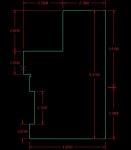I live in an apartment and, of course, I am quite restricted as to what I can do with HF activity. This applies to both SWL and amateur operations which include transmitting. Fortunately there is a tree at the head of my usual parking spot (when I get home early enough to capture it) that has a "Y" at about 12' off the ground. I use this to run a coax from my truck to my porch and then into my apartment in order to use my mobile antennas indoors. Thanks to the small diameter of the black RG-8X it hasn't been noticed by anyone so far.
Using the outdoor resonant antennas as a reference, I compare them to my indoor wire divided "loop" which runs around the parameter of the living room and dining room of the apartment at just under the ceiling level. In most cases the mobile antennas out preform the "loop", but in a few exceptions the loop is very close to the same performance. In order to see this relationship graphically I ran a scan of the loop with my FA-VA5 antenna analyzer. The loop and it's dimensions are shown below.
The loop was cut open at the "tick" mark (red X) at the 1.5240 dimension, then folded down a few inches. Therefore it is not a closed loop. This is the half point of the length of wire around it's perimeter. The feed point is at the gap between the 5.0198 and 3.3688 dimensions, and it is connected to my SDRplay RSP2 via a short (12')run of RG-8X coax.
View attachment 72753
The analyzer scan is shown below.
View attachment 72752
Value List
View attachment 72755
The main plots of interest are the SWR (red), complex impedance (blue), and the real impedance (black) relationships. There are some interesting occurrences of resonance with the antenna where the complex and real impedance come together and the reactance is canceled out, some of which where quite surprising to me such as 2.2MHz, 4.05MHz, 10MHz (not so surprising as the "loop" length is an exact full wave at 10MHz taking into account the velocity factor of the insulated wire), and 22MHz. I'm sure some of these points are due to the environment the antenna is installed in, not just it's dimensions. The listening performance with the SDRplay is in line with the chart at the frequencies where the antenna achieves resonance. Some of these resonance points are quite high in impedance but this could be, if desired, transformed by inserting the appropriate value balun when listening on these frequencies. I have temporary jumpers between certain points just to see what happens with the antenna's tuning, and this has produced quite a few interesting results. I have one jumper which, when installed, provides an unusually good coverage of the air traffic control band, despite being what I assume to be the wrong orientation. The top of the 75 meter phone band on the loop is very close to the performance of the 75 meter hamstick installed on my truck, as the chart shows with a 4.05MHz resonance. 15 meters is also very strong on the loop. The analyzer has allowed me to develop a number of combinations of good performance on desired frequencies quite easily. I recommend it very highly,
especially for SWL.



